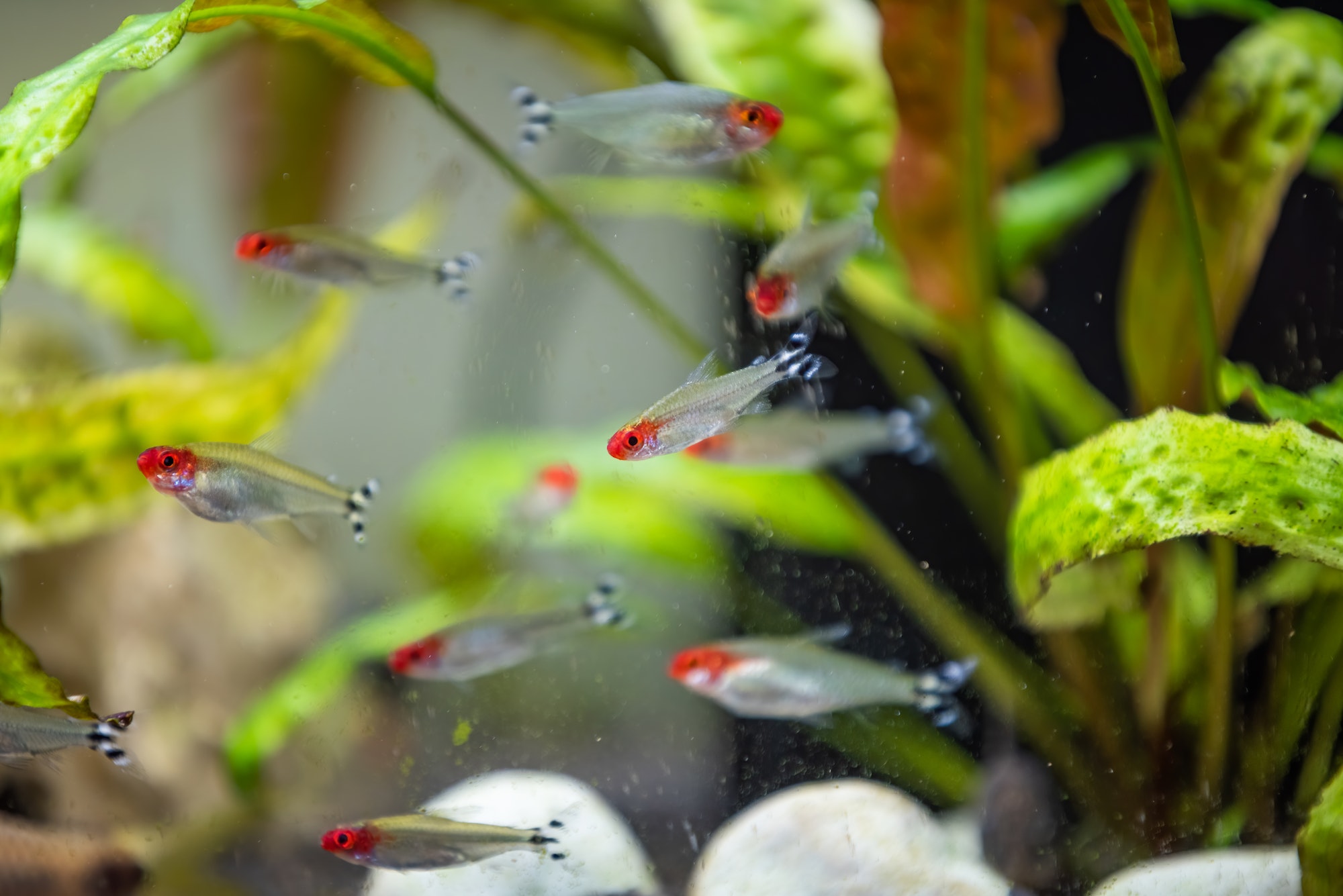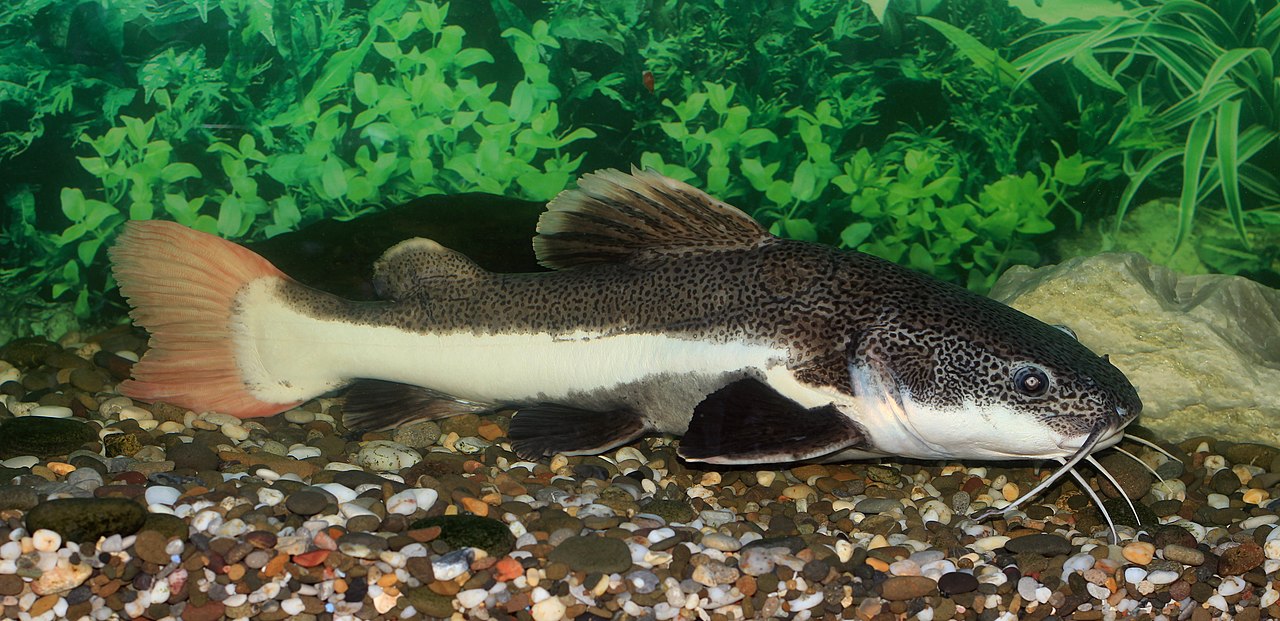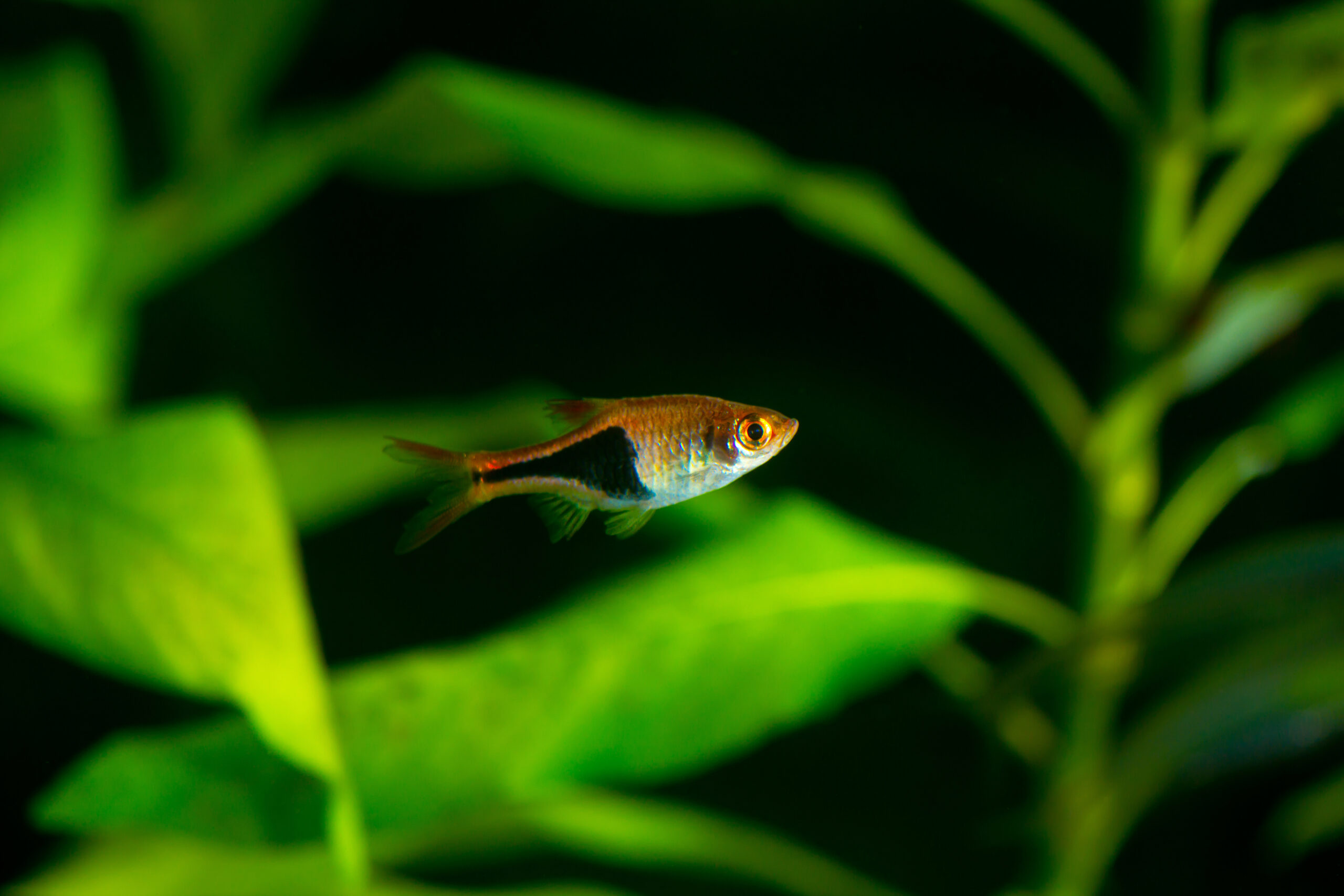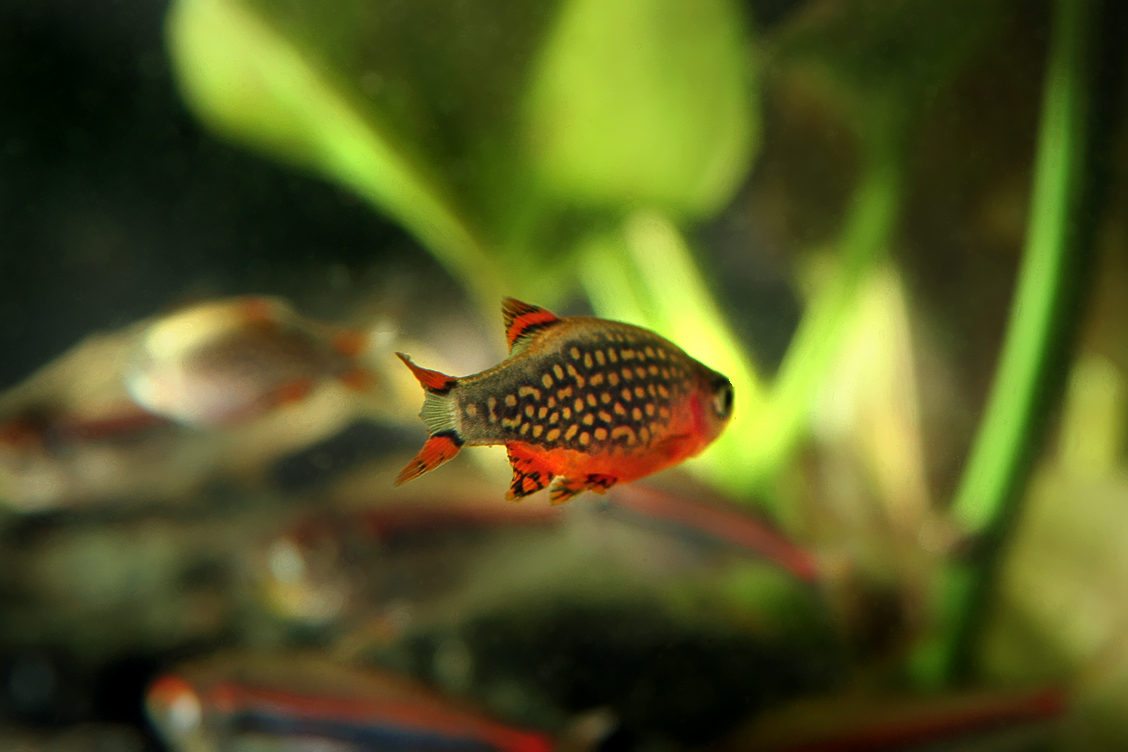Rummy Nose Tetras, scientifically known as Hemigrammus rhodostomus, are a fascinating species of tropical freshwater characin fish originating from South America. They are part of the Animalia Kingdom, Chordata Phylum, Actinopterygii Class, Characiformes Order, and Characidae Family. These Tetras share a close relationship with species like Hemigrammus bleheri and Petitella georgiae, often collectively referred to as “rummy-nose tetras.”
Table of Contents
The Rummy Nose Tetras are known for their unique coloration. They have a fusiform shape with a basal body color that is a translucent silvery color, often suffused with a greenish tint in some specimens. Their fins are hyaline, except for the caudal fin, which is adorned with black and white horizontal stripes. The head is a deep red color, iridescent in lustre, with the red continuing into the iris of the eye.
Rummy Nose Tetras are actually quite common and easy to find. Their vibrant colors and intriguing behavior make them a favored choice as a tropical aquarium fish by many fish keepers. There are several similar species to the Rummy Nose Tetra, including Hemigrammus bleheri, and Petitella georgiae, often collectively referred to as “rummy-nose tetras.”
The Tetras live in river sections with low mineral levels (soft water), which is acidic and often polluted with humic acid residues from the decomposition of leaf litter on the riverbed. They primarily reside in the central and lower-middle areas of the water column. Being a schooling species, they form groups that can range from a minimum of about 6 to sometimes more than 32 fish. Their exceptional navigational skills allow them to thrive in environments where other fish struggle to handle the excessive “noise”.
When fully grown, the average length of Rummy Nose Tetras is 5 cm (2 in). Proper maintenance can extend their lifespan in the aquarium to around 5 or 6 years. Specimens of exceptional quality have the ability to live for over 8 years. These fish are voracious eaters and will eagerly consume both prepared and live fish food. Give treats to pets 1-2 times per week for flake/pellet-based diets. This will help add some variety to their meals and keep them happy and satisfied.
One interesting fact about Rummy Nose Tetras is that they can act as a “mine canary” in an aquarium. When the levels of waste products such as ammonia, nitrites, and nitrates surpass their critical thresholds, the fish’s face gradually loses its vibrant ruby-red hue. This sign clearly indicates the importance of adjusting the water chemistry parameters during your aquarium’s maintenance routine. Moreover, it implies that the pollutant levels have escalated to a dangerous extent for the very organisms that reside within it.
The Rummy Nose Tetra was discovered by Ahl in 1924. Originating from South America, this tropical freshwater characin fish species is highly favored by fish enthusiasts as a colorful addition to their aquarium. The fish belongs to a group of closely related species, which also includes Hemigrammus bleheri and Petitella georgiae. It’s possible that the fish sold as pets could be one of these newly found species.
In conclusion, Rummy Nose Tetras are a vibrant and interesting addition to any freshwater aquarium. With their unique coloration and fascinating behavior, they are sure to be a hit with both novice and experienced fish keepers alike.
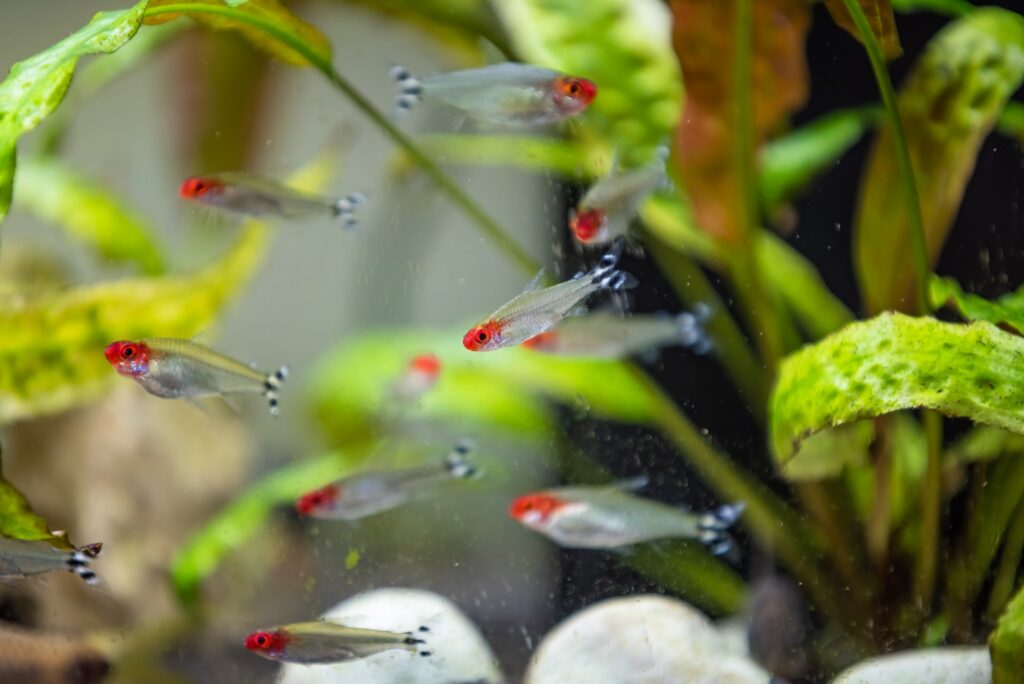
Key Information
| Family | Rummy Nose Tetras belong to the Characidae family. |
| Price | The price of Rummy Nose Tetras typically ranges around $2-$5 per fish. |
| Common Names | They are also known as Red Nose Tetra and Firehead Tetra. |
| Variants | Similar species include Hemigrammus bleheri and Petitella georgiae. |
| Ideal Tank Size | A minimum of 20 gallons is recommended for these active swimmers. |
| Water Parameters | They thrive in water temperatures of 75-84°F (24-29°C), a pH level of 5.5-7.0, and a hardness of 2-12 dGH. |
| Lifespan | Rummy Nose Tetras typically live for 5 to 6 years in an aquarium setting, with some living up to 8 years. |
| Full Size | They grow up to 5 cm (2 in) in length. |
| Natural Environment | They originate from the blackwater rivers of South America. |
| Behavior | They are peaceful, schooling fish that prefer to swim in the middle and lower levels of the tank. |
| Habitat Preference | They prefer soft, acidic water conditions similar to their natural habitat. |
| Aquarium Decoration | They appreciate aquariums with plenty of plants, as well as driftwood and rocks for hiding places. |
| Ideal Tank Mates | Ideal tank mates include Cardinal Tetras, Neon Tetras, Corydoras Catfish, Dwarf Gouramis, Discus, and Angelfish. |
| Fish to Avoid | Aggressive or large predatory fish should be avoided. |
| Best Foods/Diet | They can be fed a staple diet of high-quality flake or pellet food, with occasional treats of live or frozen foods. |
| Disease | They are susceptible to common fish diseases such as Ich and Fin Rot. |
| Sex-switch | Rummy Nose Tetras do not exhibit sex-switching behavior. |
| Gender Differences | Gender differences in Rummy Nose Tetras are not easily distinguishable. |
| Care Level | They have an easy to intermediate care level. |
| Breeding Level | Breeding Rummy Nose Tetras is considered to be at an intermediate level. |
Ideal Tank Mates
Rummy Nose Tetras are peaceful schooling fish that get along well with many other species in a community tank. They are best paired with other non-aggressive fish that thrive in similar water conditions. Here are detailed descriptions of 10 ideal tank mates for Rummy Nose Tetras:
Cardinal Tetras
Cardinal Tetras are a fantastic choice for a tank mate for Rummy Nose Tetras. They are both peaceful, schooling fish that prefer similar water conditions. Cardinal Tetras are also similar in size to Rummy Nose Tetras, which helps prevent any issues with bullying or aggression.
Neon Tetras
Neon Tetras are another great option. They are small, peaceful fish that also prefer to be in schools. Their bright blue and red coloring can provide a nice contrast to the red, black, and white coloring of the Rummy Nose Tetras.
Corydoras Catfish
Corydoras Catfish are bottom dwellers, which can add some diversity to your tank. They are peaceful and get along well with Rummy Nose Tetras. Plus, they can help keep the bottom of your tank clean by eating leftover food.
Dwarf Gouramis
Dwarf Gouramis are peaceful, slow-moving fish that can add some color and variety to your tank. They prefer similar water conditions to Rummy Nose Tetras and are generally easy to care for.
Discus
Discus are larger fish that prefer warm, soft, and slightly acidic water, just like Rummy Nose Tetras. They are peaceful and can coexist well with Rummy Nose Tetras, but due to their size, they should be kept in larger tanks.
Angelfish
Angelfish can also be good tank mates for Rummy Nose Tetras, but care should be taken as they can sometimes be semi-aggressive. They are larger and prefer similar water conditions. Their unique shape and variety of colors can add interest to your tank.
Harlequin Rasboras
Harlequin Rasboras are small, peaceful fish that are easy to care for. They prefer to be in schools and can coexist well with Rummy Nose Tetras. Their orange and black coloring can provide a nice contrast in your tank.
Guppies
Guppies are small, active fish that come in a variety of colors. They are peaceful and easy to care for, making them a good choice for a community tank with Rummy Nose Tetras.
Mollies
Mollies are adaptable, peaceful fish that can get along well with Rummy Nose Tetras. They come in a variety of colors and can adapt to a range of water conditions.
Platies
Platies are small, colorful fish that are easy to care for. They are peaceful and can coexist well with Rummy Nose Tetras. They prefer similar water conditions and can add a splash of color to your tank.
FAQs
Can Rummy Nose Tetras live with Betta fish?
While it’s possible for Rummy Nose Tetras to coexist with Betta fish, it’s important to monitor the tank closely. Bettas can sometimes be aggressive, and the active swimming of the Tetras might stress them. Always ensure there’s enough space and hiding spots for all fish.
What is the color change in Rummy Nose Tetras indicative of?
The color change in Rummy Nose Tetras, specifically the fading of the red color in their faces, is often an indicator of poor water quality. It can be a sign that levels of certain metabolic wastes like ammonia, nitrites, and nitrates are too high.
How many Rummy Nose Tetras should be kept together?
Rummy Nose Tetras are schooling fish and should be kept in groups of at least 6. However, larger groups are preferable if space allows, as this can help the fish feel more secure and display more natural behavior.
Can Rummy Nose Tetras live in a planted tank?
Yes, Rummy Nose Tetras thrive in planted tanks. The plants provide cover, mimic their natural environment, and can also help to maintain water quality.
Do Rummy Nose Tetras jump?
Like many fish species, Rummy Nose Tetras have been known to jump, especially when stressed or if the water conditions are poor. It’s a good idea to have a lid on your aquarium to prevent any accidental jumps.
Can Rummy Nose Tetras live in hard water?
Rummy Nose Tetras prefer soft to moderately hard water. If your tap water is very hard, it might not be the best fit for these fish. They thrive in water with a hardness of 2-12 dGH.
How do I know if my Rummy Nose Tetras are healthy?
Healthy Rummy Nose Tetras will have clear eyes, vibrant colors, and an active demeanor. They should be eager to eat and swim with their school. A lack of appetite, lethargy, faded colors, or visible spots or fungus could be signs of illness.
Can Rummy Nose Tetras live alone?
Rummy Nose Tetras are schooling fish and should not be kept alone. They thrive in groups of at least 6, and keeping them in a school can help them feel secure and exhibit natural behaviors.
Do Rummy Nose Tetras hide?
Rummy Nose Tetras may hide if they’re feeling stressed or threatened. Providing plenty of plants, rocks, and hiding spots in the aquarium can help them feel more secure. However, if your Tetras are hiding more than usual, it could be a sign of stress or illness.
Can Rummy Nose Tetras eat peas?
While Rummy Nose Tetras can technically eat peas, they are not a necessary part of their diet. These fish are omnivores and can eat a variety of foods, but they primarily prefer small, meaty foods like brine shrimp or bloodworms. If you choose to feed peas, make sure they are cooked, shelled, and cut into small pieces.

